The content of these files is fascinating – they include transcripts of interrogations, and of bugged telephone calls, surveillance reports, memos, reports, and correspondence – items that were considered ‘Secret’ or ‘Top Secret’ for so many years. This release, therefore, brings us rich layers of extra detail that can be added to the ‘known’ story.
Who were The Cambridge Five?
Harold ‘Kim’ Philby, Guy Burgess, Donald Maclean, Anthony Blunt and John Cairncross formed the most infamous spy ring of the 20th century: the Cambridge Five.
They are commonly referred to as a ‘spy ring’, which suggests a cohesive unit. This is a misnomer, however, as although there was cross-connection and co-conspiracy between them, they took separate paths and operated independently to a significant degree. But they certainly had this in common: all were graduates of Cambridge University, and were recruited by Soviet Intelligence during the 1930s.
During the Second World War and after, they passed highly classified information to the Soviet Union. By the early 1950s they had penetrated all the major institutions of British state security.
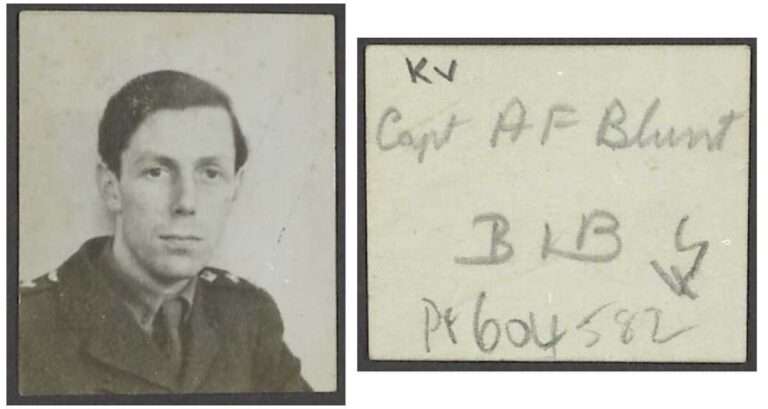
A newly released photo of a young Anthony Blunt. Catalogue reference: KV 2/4700
Highlights from this release: Kim Philby
Following the disappearance of Burgess and Maclean in 1951, Philby fell under suspicion and was summoned home from Washington for interviews with Dick White, the Chief of MI5 counter-intelligence. The transcripts can be found in KV 2/4723, and they show how Philby tried to deflect blame onto Burgess for alerting Maclean that he had been unmasked as a spy.
On 12 December 1951, Philby was interviewed by Helenus ‘Buster’ Milmo, a barrister and an MI5 Officer. The eighty nine page transcript in KV 2/4727 shows that it was a very exacting interrogation, a determined attempt to get Philby to confess his guilt as a spy for the Soviet Union. Philby did not concede this, but the transcript shows that he frequently had no answer to Milmo’s forensic lines of questioning.
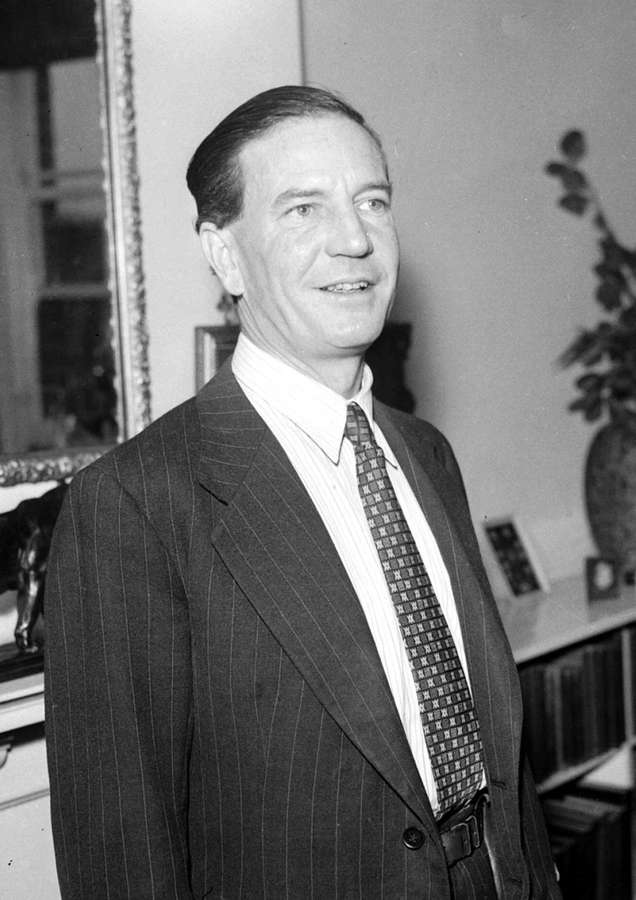
Kim Philby at a press conference in 1955. Image: PA Images / Alamy Stock Photo
In 1962 proof emerged that Philby was indeed a Soviet agent, and, in January 1963, an MI6 officer went out to Beirut to confront him. MI6 policy is not to name officers (and the officer’s name has been redacted in the MI5 files), but it is commonly known that the person who confronted Philby was his old friend, Nicholas Elliott.
KV 2/4737 contains the records generated by that encounter, including Philby’s confession statement, dated 11 January 1963 – a partial confession, covering 1932 to 1940. In the transcripts of conversations between the two men in Beirut, Philby claimed to have spied for the Soviet Union from 1934 to 1946, but gave no meaningful explanation about why he allegedly desisted.
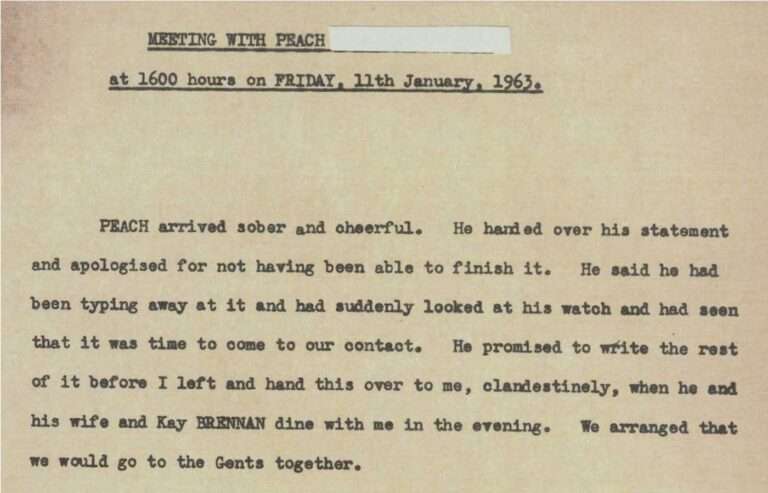
MEETING WITH PEACH [redacted]
at 1600 hours on FRIDAY, 11th January, 1963.
PEACH arrived sober and cheerful. He handed over his statement and apologised for not having been able to finish it. He said he had been typing away at it and had suddenly looked at his watch and had seen that it was time to come to our contact. He promised to write the rest of it before I left and hand this over to me, clandestinely, when he and his wife and Kay BRENNAN dine with me in the evening. We arranged that we would go to the Gents together.
Extract from the MI6 agent’s account of confronting Philby, who had been codenamed PEACH when he first fell under suspicion in 1951. Catalogue reference: KV 2/4737
The transcripts reveal that Philby made a fleeting but significant admission, that he had passed on information to the Russians about Konstantin Volkov. A Soviet intelligence officer stationed in Turkey, Volkov had privately offered to defect to the UK – before he and his wife were taken by Soviet agents and executed in the Lubyanka in Moscow.
Highlights from this release: Anthony Blunt
KV 2/4705 includes a riveting account of an interview with Anthony Blunt by MI5 Officer Arthur Martin, in Blunt’s flat above the Courtauld Institute on 23 April 1964, in which he finally confessed to having been a spy for the Soviet Union.
Although Blunt had been given an assurance that no action would be taken against him if he now told the truth, Martin was left with the impression that Blunt was still withholding certain information.
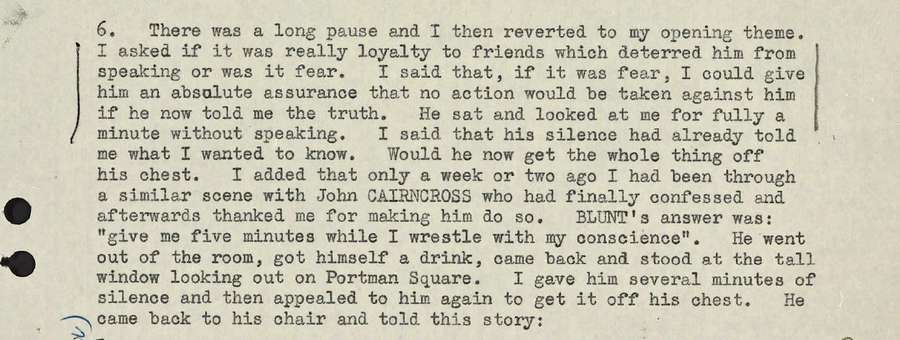
6. There was a long pause and I then reverted to my opening theme. I asked if it was really loyalty to friends which deterred him from speaking or was it fear. I said that, if it was fear, I could give him an absolute assurance that no action would be taken against him if he now told me the truth. He sat and looked at me for fully a minute without speaking. I said that his silence had already told me what I wanted to know. Would he now get the whole thing off his chest. I added that only a week or two ago I had been through a similar scene with John CAIRNCROSS who had finally confessed and afterwards thanked me for making him do so. BLUNT's answer was: "give me five minutes while I wrestle with my conscience". He went out of the room, got himself a drink, came back and stood at the tall window looking out on Portman Square. I gave him several minutes of silence and then appealed to him again to get it off his chest. He came back to his chair and told this story:
Extract from Arthur Martin’s account of his interview with Anthony Blunt, 23 April 1964. Catalogue reference: KV 2/4705
From 1945 onwards Blunt was appointed Surveyor of the King’s (and later the Queen’s) Pictures, responsible for the Royal Collection of Pictures. He held that position until 1972, and remained in an advisory capacity to the Royal Collection until 1978. As such, Blunt remained at the heart of the establishment for over 30 years. In KV 2/4721 we learn that in 1973 the Queen was told about his case.
Further highlights
KV 2/4691 includes an account – again by Arthur Martin – of an interview with John Cairncross, which took place in Ohio on 16 February 1964. In the interview Cairncross admitted that he had been recruited by the Russian Intelligence Service (RIS) in 1936, soon after he joined the Foreign Office.
He goes on to talk about his first encounters with Maclean, Burgess and Philby, his work on decrypted messages at Bletchley Park and his career path in general. Very little material has been released about Cairncross before – 22 files concerning him are now made available in this release (as well as 22 files on Blunt and 21 files on Philby).
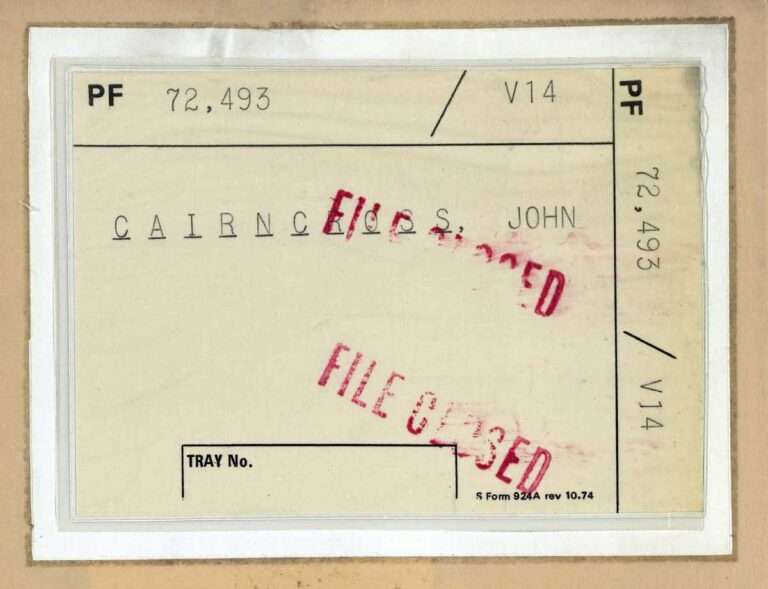
Cover from an MI5 file on John Cairncross. Catalogue reference: KV 2/4691
The release also includes files (KV 2/4744–4754) concerning Italian nuclear physicist Giuseppe Martelli, a nuclear physicist who was arrested under the Official Secrets Act in 1963, while in possession of espionage-related paraphernalia. He was suspected of working as an agent for the Russian Intelligence Service and was prosecuted but found not guilty.
There is also a file (KV 2/4673) concerning Dirk Bogarde, the famous actor and writer. Following up on information from a source, MI5 thought that he may have been approached by the Russian Intelligence Service. MI5 interviewed Bogarde in 1971 and established that there was no cause for suspicion.
In addition, the release contains some policy files in the series KV 4, including MI5’s liaison relationship with the FBI, 1949–55, and liaison between the Director General and the Prime Minister, 1963–68.
MI5: Official Secrets
The stories of the Cambridge Five, and others enhanced by these new releases, will feature in the forthcoming major exhibition at The National Archives, MI5: Official Secrets, which opens in the spring.
The exhibition will mark the first time MI5’s secret history is going on display to the public, featuring original case files, photographs and papers, alongside the actual equipment used by spies and spy-catchers over the Security Service’s 100-year history. And it’s free, so do plan to visit if you can!
You can also find links to further new spy-related articles on the exhibition webpage, including the story of Karl Muller and the fatal lemon, dating back to the early days of MI5 (around the First World War).
Past exhibition
MI5: Official Secrets
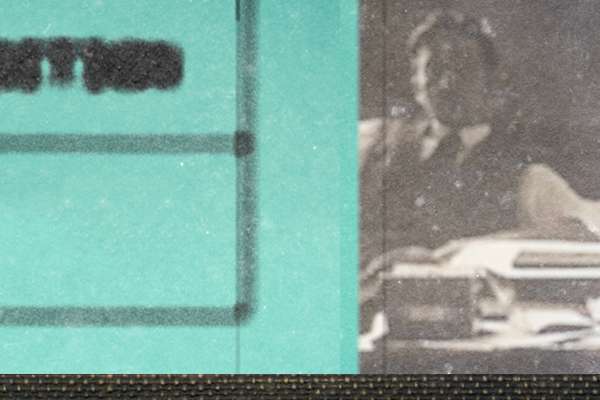
This 2025 exhibition allowed visitors to step inside the hidden world of MI5 and explore the extraordinary stories behind the security of a nation.
